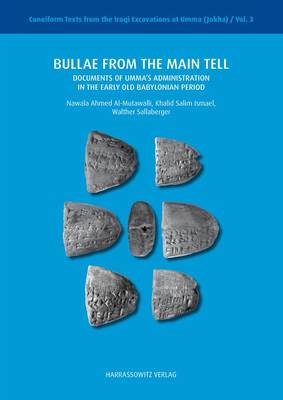
Bedankt voor het vertrouwen het afgelopen jaar! Om jou te bedanken bieden we GRATIS verzending (in België) aan op alles gedurende de hele maand januari.
- Afhalen na 1 uur in een winkel met voorraad
- In januari gratis thuislevering in België
- Ruim aanbod met 7 miljoen producten
Bedankt voor het vertrouwen het afgelopen jaar! Om jou te bedanken bieden we GRATIS verzending (in België) aan op alles gedurende de hele maand januari.
- Afhalen na 1 uur in een winkel met voorraad
- In januari gratis thuislevering in België
- Ruim aanbod met 7 miljoen producten
Zoeken
Bullae from the Main Tell
Documents of Ummas Administration in the Early Old Babylonian Period
Nawala Ahmed Al-Mutawalli, Khalid Salim Ismael, Walther Sallaberger
€ 227,45
+ 454 punten
Omschrijving
The administration of Umma was housed in a building adjoining the temple of the city god Shara. There, on the main tell, the Iraqi excavators, directed by the State Board of Antiquities and Heritage, found a collection of clay bullae dating from the time of Sumuel of Larsa. Most of these cuneiform documents, 236 out of the 278 artefacts published in this book, register losses of the sheep and goat herds of Umma's institutions. The group of people involved in the administration, the date formulae of local rulers and the gods and festivals mentioned allow new insights into the functioning of a southern Mesopotamian city in the age of the Amorite dynasties. In addition to the first publication of the cuneiform bullae, the volume also contains a general analysis, a chapter on the seal images by Adelheid Otto and detailed indexes.
Specificaties
Betrokkenen
- Auteur(s):
- Uitgeverij:
Inhoud
- Aantal bladzijden:
- 348
- Taal:
- Engels
- Reeks:
- Reeksnummer:
- nr. 3
Eigenschappen
- Productcode (EAN):
- 9783447121705
- Verschijningsdatum:
- 31/12/2024
- Uitvoering:
- Hardcover
- Formaat:
- Genaaid
- Afmetingen:
- 218 mm x 28 mm
- Gewicht:
- 167 g

Alleen bij Standaard Boekhandel
+ 454 punten op je klantenkaart van Standaard Boekhandel
Beoordelingen
We publiceren alleen reviews die voldoen aan de voorwaarden voor reviews. Bekijk onze voorwaarden voor reviews.









